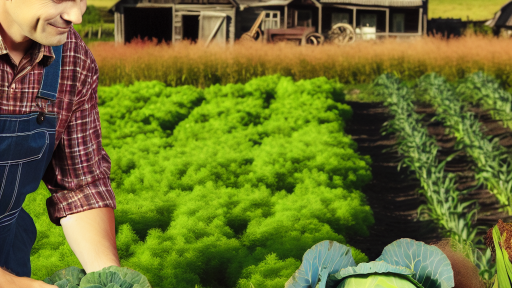Understanding Direct Sales
Definition of Direct Sales
Direct sales involve selling products directly to consumers.
This approach eliminates intermediaries such as retailers and distributors.
Farmers can market their own produce and products straight to buyers.
As a result, farmers maintain better control over pricing and quality.
Benefits for Farmers
Direct sales offer numerous advantages for farmers.
Firstly, it allows for an increase in profit margins.
By selling directly, farmers can retain all revenue from sales.
Additionally, direct sales enhance consumer relationships.
Farmers can build a loyal customer base through personal interactions.
Flexibility in Business Operations
Direct sales provide greater flexibility in how products are marketed.
Farmers can customize offerings based on consumer preferences.
This approach helps in adjusting prices based on market demand.
Moreover, farmers can introduce new products quickly and efficiently.
Building a Community Connection
Through direct sales, farmers contribute to local economies.
They create jobs and support local businesses.
Transform Your Agribusiness
Unlock your farm's potential with expert advice tailored to your needs. Get actionable steps that drive real results.
Get StartedFurthermore, direct engagement fosters a sense of community.
Consumers appreciate knowing where their food comes from.
This connection often leads to increased sales and brand loyalty.
Challenges to Consider
While direct sales have many benefits, challenges also exist.
Farmers may face competition from larger businesses.
Additionally, managing direct sales requires time and effort.
Farmers need effective marketing strategies to reach their audience.
Identifying Your Target Market for Farm Products
Understanding Your Products
Your farm likely offers a range of products.
Each product appeals to different markets.
Begin by listing what you produce.
Consider factors like quality and uniqueness.
Understanding your offerings helps define your audience.
Researching Customer Demographics
Identify the characteristics of your potential customers.
Age, gender, and income levels matter.
Use surveys or local market research for insights.
Visit local events to gather information in person.
Online tools also provide valuable demographic data.
Exploring Market Segments
Different segments can include families, chefs, or health enthusiasts.
Identify which groups align with your farm’s products.
Consider the purchasing habits of these segments.
Do they prefer organic, local, or value pricing?
Understanding segments enhances marketing efforts.
Utilizing Social Media and Online Platforms
Social media offers tools to engage potential customers.
Create engaging content that showcases your products.
Showcase Your Farming Business
Publish your professional farming services profile on our blog for a one-time fee of $200 and reach a dedicated audience of farmers and agribusiness owners.
Publish Your ProfileJoin local groups and forums to interact with your audience.
Use ads targeted to specific demographics.
This engagement helps build a loyal customer base.
Networking and Community Engagement
Your local community is a rich source of potential customers.
Attend farmers’ markets, fairs, or local festivals.
Networking with other farmers can provide insights.
Collaborate on promotions to reach a larger audience.
Building relationships fosters trust in your brand.
Assessing Competitors
Knowing your competitors helps you identify gaps.
Analyze their offerings and market strategies.
Look for what they do well and where they fall short.
This analysis can reveal opportunities for your farm.
Finding a niche sets you apart in the market.
Selecting the Right Products to Sell Directly from Your Farm
Understanding Your Market
Begin by analyzing the local market trends.
Identify what products are currently in demand.
Explore consumer preferences regarding organic versus conventional options.
Additionally, assess seasonal trends that may influence sales.
Identifying Your Farm’s Strengths
Evaluate the unique offerings of your farm.
Consider what products you can produce sustainably and in abundance.
Highlight any specialty products that differentiate you from competitors.
Farm tours and tastings can showcase these strengths effectively.
Considering Product Variety
Offer a variety of products to attract different customer segments.
For instance, combine fresh produce with value-added items.
Consider selling items like jams, jellies, or pickles.
Diversifying your product range can increase customer interest.
Networking with Local Businesses
Build relationships with local restaurants and shops.
These partnerships can help broaden your market reach.
Consider hosting events that promote your products with local chefs.
Collaboration enhances visibility and strengthens community ties.
Testing Your Products
Before full-scale offerings, test your products with select customers.
Gather feedback to understand preferences and potential improvements.
Sampling products at local farmers’ markets can provide valuable insights.
Adjust your product offerings based on consumer responses.
Marketing Your Products
Develop a clear marketing strategy for your direct sales.
Utilize social media platforms to create awareness and engagement.
Learn about local advertising options, including community boards and local newspapers.
Engage your audience with compelling stories about your farm and products.
You Might Also Like: Integrating Seasonal Eating into Your Farming Operation
Creating an Effective Marketing Strategy for Direct Sales
Understanding Your Audience
Identifying your target customers is crucial for successful marketing.
Conduct surveys to learn about their preferences and needs.
Showcase Your Farming Business
Publish your professional farming services profile on our blog for a one-time fee of $200 and reach a dedicated audience of farmers and agribusiness owners.
Publish Your ProfileUse social media to engage potential customers and gather insights.
Analyze your competitors’ audience to understand market demand.
Building Your Brand
Develop a strong brand identity that reflects your farm’s values.
Create a memorable logo and a cohesive visual style.
Use storytelling to connect emotionally with your audience.
Showcase your farming practices and product benefits clearly.
Creating a Marketing Plan
Outline your marketing goals and strategies in a clear plan.
Set a budget to allocate resources effectively.
Include both online and offline marketing channels in your plan.
Regularly evaluate your strategies for improvements.
Utilizing Social Media
Choose the right platforms to reach your audience effectively.
Post engaging content that showcases your products and farm life.
Interact with your followers to build a loyal customer base.
Use targeted ads to increase visibility and attract new customers.
Participating in Local Events
Join local farmers’ markets and community events to showcase your products.
Build relationships with customers by sharing your farming story.
Offer product samples to encourage trial and purchases.
Network with other local businesses to expand your reach.
Establishing Online Sales Channels
Create a user-friendly website to highlight your products.
Set up an online store to facilitate purchases directly from customers.
Implement secure payment methods to build customer trust.
Utilize email marketing to inform customers about new products and promotions.
Tracking and Analyzing Performance
Monitor your marketing efforts to gauge effectiveness regularly.
Use analytics tools to track sales and customer engagement.
Adjust your strategies based on performance data to optimize results.
Incorporate customer feedback to improve your offerings.
Delve into the Subject: Seasonal Agri-Tourism Ideas for Every Farm
Setting Up a Sales Platform
Farmers’ Markets
Farmers’ markets provide a vibrant space for direct sales.
You will connect with local consumers seeking fresh produce.
Additionally, these markets allow you to engage with your community.
To start, research local farmers’ markets in your area.
Contact the market organizers to understand application processes.
Ensure you comply with local health regulations.
Consider offering samples to attract customers to your booth.
Promote your presence on social media for greater visibility.
Online Sales
Online sales expand your reach beyond local consumers.
Create a website or use established platforms to showcase your products.
Leverage social media to drive traffic to your online store.
Consider using e-commerce platforms like Shopify or Etsy.
Ensure your website is user-friendly and mobile-compatible.
Showcase Your Farming Business
Publish your professional farming services profile on our blog for a one-time fee of $200 and reach a dedicated audience of farmers and agribusiness owners.
Publish Your ProfileInvest in quality photography to highlight your products.
Offer promotions or discounts to encourage initial purchases.
Collect customer reviews to build trust with potential buyers.
Farm Stands
Farm stands offer a convenient way to sell directly from your farm.
Determine a suitable location for maximum visibility and accessibility.
Set up a welcoming atmosphere with signage and displays.
Use fresh, vibrant produce to attract passersby.
Establish clear pricing and payment options for customers.
Consider extending your hours, especially during peak seasons.
Provide a variety of products to cater to different tastes.
Engage with customers to create a personal shopping experience.
Discover More: Sustainable Practices in Farm-to-School Projects
Building Customer Relationships and Engagement Techniques
Understanding Your Customers
Start by identifying the needs of your customers.
Conduct surveys to gather data on their preferences.
Analyze this data to understand buying habits.
Use this information to create tailored marketing strategies.
Establishing Trust
Transparency is essential in building trust with customers.
Share your farming practices openly and honestly.
Engage with customers on social media platforms.
Respond promptly to inquiries and feedback.
Utilizing Storytelling
Share stories about your farm and its history.
Include details about your farming practices and values.
Stories create emotional connections with your audience.
They help customers feel a part of your farming journey.
Creating Engaging Content
Produce high-quality content that educates your audience.
Provide tips on cooking with fresh ingredients.
Share recipes featuring your farm products.
Utilize videos to showcase your farm and product offerings.
Implementing a Rewards Program
Introduce a rewards program to encourage loyalty.
Offer discounts or free products after certain purchases.
This strategy motivates repeat business from customers.
Hosting Events and Workshops
Organize farm tours to invite customers onto your land.
Host workshops that teach farming or cooking skills.
These events strengthen community ties and customer loyalty.
Encouraging Customer Feedback
Actively ask for customer feedback on products and services.
Implement constructive feedback to improve offerings.
Show customers their opinions are valued and important.
Leveraging Social Media
Use social media platforms to reach a broader audience.
Share updates, promotions, and engaging content regularly.
Create a conversation through polls and interactive posts.
Showcase Your Farming Business
Publish your professional farming services profile on our blog for a one-time fee of $200 and reach a dedicated audience of farmers and agribusiness owners.
Publish Your ProfileEngagement on social media fosters customer relationships.
Explore Further: Financial Planning Strategies for Community Supported Agriculture

Managing Inventory and Pricing Strategies for Direct Sales
Effective Inventory Management
Managing inventory is crucial for direct sales success.
Start by tracking all your products accurately.
This means knowing what you have available for customers.
Consider using inventory management software.
It helps streamline your processes significantly.
Regularly check your stock levels to avoid shortages.
Additionally, keep an eye on seasonal trends and demands.
Adjust your inventory based on customer preferences.
Creating Competitive Pricing Strategies
Pricing your products effectively attracts more customers.
Begin with an analysis of your costs to understand your expenses.
Then, research your competitors’ prices in the market.
Consider offering discounts for bulk purchases.
This encourages customers to buy more while boosting sales.
Don’t forget about the perceived value of your products.
Quality products often justify higher prices.
Utilizing Sales Promotions
Sales promotions can drive traffic to your business.
Consider seasonal sales or holiday promotions.
Offer limited-time discounts to create urgency.
Utilize social media to advertise your promotions effectively.
This will also help you reach a broader audience.
Building Customer Relationships
Developing strong relationships with customers is essential.
Ensure excellent customer service at all times.
Engage with your customers through social media and newsletters.
Listen to their feedback and implement improvements.
A loyal customer base often leads to repeat sales.
Monitoring Sales Performance
Regularly review your sales data to make informed decisions.
Identify patterns that can guide your future strategies.
Analyze what products sell well and which don’t.
This will enhance your inventory management and pricing strategies.
Continuous monitoring helps refine your approach effectively.
Navigating Legal Requirements and Regulations for Direct Sales
Understanding Permits and Licenses
Before launching direct sales, obtain necessary permits and licenses.
Regulations vary by state and municipality.
Check with local agricultural offices for guidance.
Special permits may be required for selling certain products.
Keep all documentation organized for inspections.
Complying with Food Safety Standards
Food safety standards are crucial in direct sales.
Familiarize yourself with local health department regulations.
Conduct regular sanitation and safety training for employees.
Showcase Your Farming Business
Publish your professional farming services profile on our blog for a one-time fee of $200 and reach a dedicated audience of farmers and agribusiness owners.
Publish Your ProfileImplement strict hygiene practices in your production area.
Label products accurately, including ingredients and allergens.
Understanding Tax Obligations
Tax obligations are another essential aspect of direct sales.
Register for sales tax collection if required in your area.
Keep detailed records of all sales transactions.
Consult a tax professional for guidance on deductions.
Stay informed about tax policy changes that may affect you.
Liability and Insurance Considerations
Insurance protects your farm from potential risks.
Evaluate various insurance options available to farmers.
Consider general liability and product liability insurance.
Research local requirements for coverage amounts.
Regularly review your insurance policy for necessary updates.
Staying Informed on Regulations
Stay updated on changes in agricultural regulations.
Join local farming organizations for networking and support.
Attend workshops and seminars related to direct sales.
Follow reputable online resources for regulatory updates.
Engage with local government representatives on agricultural matters.
Utilizing Social Media and Online Advertising to Boost Sales
Leveraging Social Media Platforms
Social media platforms are ideal for promoting farm products.
Choose platforms that fit your target audience.
For example, Instagram is perfect for visually appealing content.
Engage with users by sharing photos of your farm and products.
Consider posting recipes or usage ideas for your offerings.
Use hashtags relevant to your niche to increase visibility.
Connect with local farmers’ markets or community groups too.
Creating Quality Content
High-quality content captures attention and builds trust.
Invest time in creating engaging visuals and videos.
Share behind-the-scenes content to tell your farm’s story.
Consider live streams or Q&A sessions to interact with viewers.
Maintain a consistent posting schedule to stay relevant.
Online Advertising Techniques
Online advertising can reach wider audiences effectively.
Explore options like Facebook Ads and Google Ads.
Set a budget that suits your financial capabilities.
Target specific demographics that are likely to buy your products.
Use compelling ad copies and strong visuals to attract clicks.
Building an Email List
Email marketing remains a strong tool for direct sales.
Encourage website visitors to subscribe to your newsletter.
Offer incentives like discounts or exclusive recipes for sign-ups.
Send regular updates about products, promotions, and events.
Personalize emails to make customers feel valued.
Engaging Your Community
Active community engagement boosts your brand reputation.
Showcase Your Farming Business
Publish your professional farming services profile on our blog for a one-time fee of $200 and reach a dedicated audience of farmers and agribusiness owners.
Publish Your ProfileParticipate in local events and farmers’ markets.
Collaborate with local businesses for cross-promotions.
Share your farm’s story to connect with potential customers.
Create community-focused content to strengthen relationships.
Evaluating Sales Performance and Adapting Strategies for Success
Setting Clear Sales Goals
Begin by establishing measurable sales goals for your farm.
These goals should be both realistic and achievable within a specific timeframe.
For instance, aim to increase sales by 20% over the next year.
Additionally, consider diversifying your product offerings to attract a wider customer base.
Monitoring Sales Performance
Consistently track sales data to understand your performance.
This data will help identify trends and areas needing improvement.
Utilize tools like spreadsheets or dedicated software to manage this data efficiently.
Furthermore, analyze sales figures regularly to adapt your approach as needed.
Gathering Customer Feedback
Encourage customers to provide feedback on their purchasing experience.
Use surveys or informal conversations to gather insights.
This feedback can guide adjustments to your products and services.
Pay attention to common themes in customer suggestions.
Adapting Sales Strategies
Stay flexible with your sales strategies based on the information gathered.
If a particular product isn’t selling, consider promotional discounts.
Also, explore different marketing channels, such as social media or farmers’ markets.
Experimenting with new sales approaches can yield unexpected benefits.
Assessing Competitors
Regularly evaluate competitors to understand their strengths and weaknesses.
This assessment can reveal opportunities for your own farm.
For example, if a competitor offers higher quality, consider enhancing your product quality.
Keeping tabs on competitor pricing can also inform your pricing strategy.
Implementing Adjustments
Once you identify areas for improvement, implement your changes promptly.
Make sure to communicate these changes to your team and stakeholders.
Monitor the effects of these adjustments on sales performance.
Be prepared to iterate further based on this ongoing evaluation.
Additional Resources
Mailboxes, Mom and Pop Stands, and Markets: Local Foods Then …
The Role of Local and Regional Food Systems in U.S. Farm Policy




